Analyzing the Feasibility of a Common Currency for ASEAN Nations
VerifiedAdded on 2020/04/21
|10
|2761
|347
Essay
AI Summary
This essay critically examines the potential adoption of a common currency by the Association of Southeast Asian Nations (ASEAN), drawing parallels and lessons from the Eurozone's experience. The analysis considers the economic and political landscapes of ASEAN member states, highlighting the varying levels of economic development among countries like Singapore, China, and those in earlier stages of development. The essay explores the advantages of monetary integration, such as reduced transaction costs and enhanced economic stability, while also addressing significant challenges, including differing economic policies, external economic shocks, and political disparities that could hinder the success of a unified currency. Furthermore, the essay emphasizes that the differences in economic development among ASEAN countries and the potential for economic underperformance, as seen in the Eurozone, pose substantial barriers to successful monetary integration. The conclusion reinforces the idea that the ASEAN should carefully evaluate the experience of the Eurozone, particularly the political and economic conditions, before moving forward with a common currency initiative.
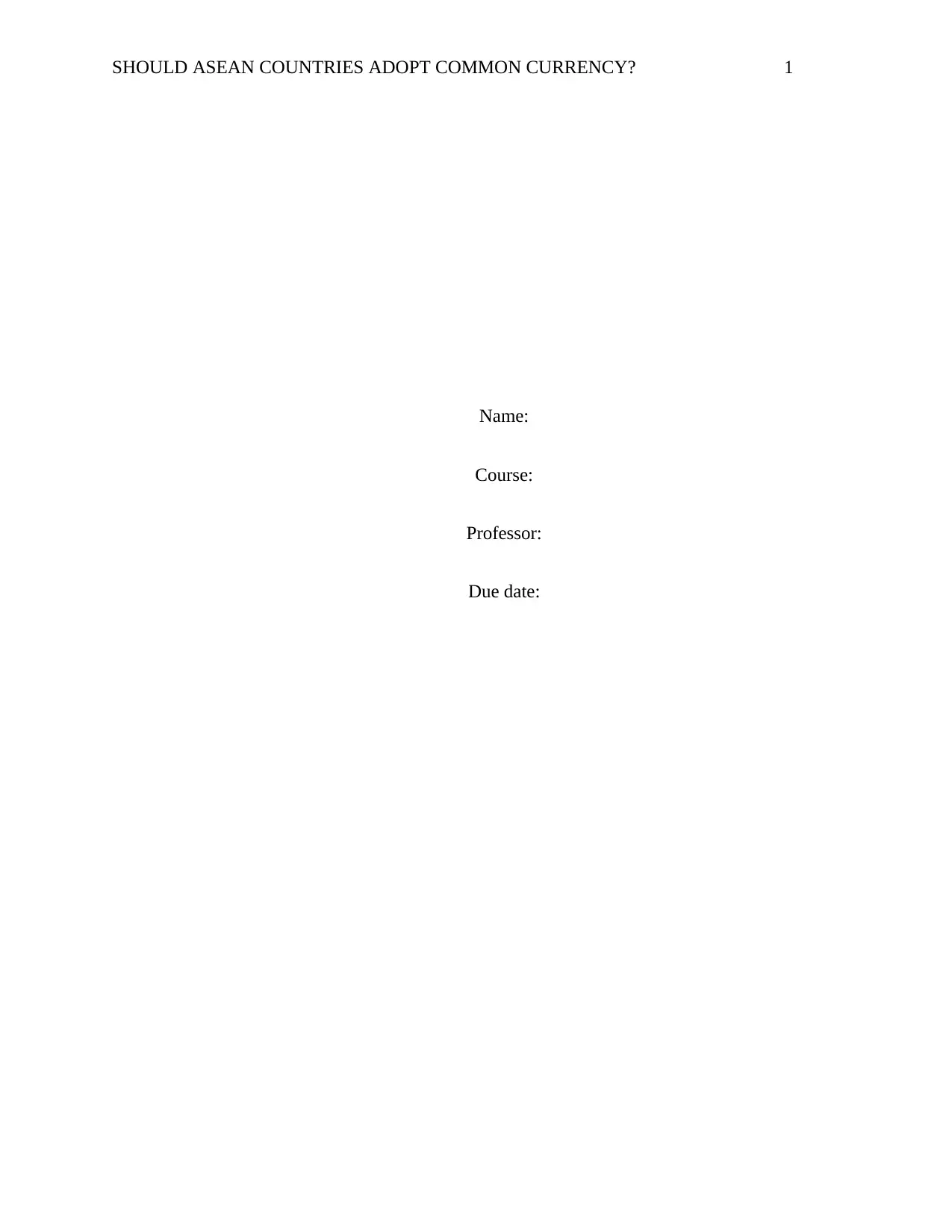
SHOULD ASEAN COUNTRIES ADOPT COMMON CURRENCY? 1
Name:
Course:
Professor:
Due date:
Name:
Course:
Professor:
Due date:
Paraphrase This Document
Need a fresh take? Get an instant paraphrase of this document with our AI Paraphraser
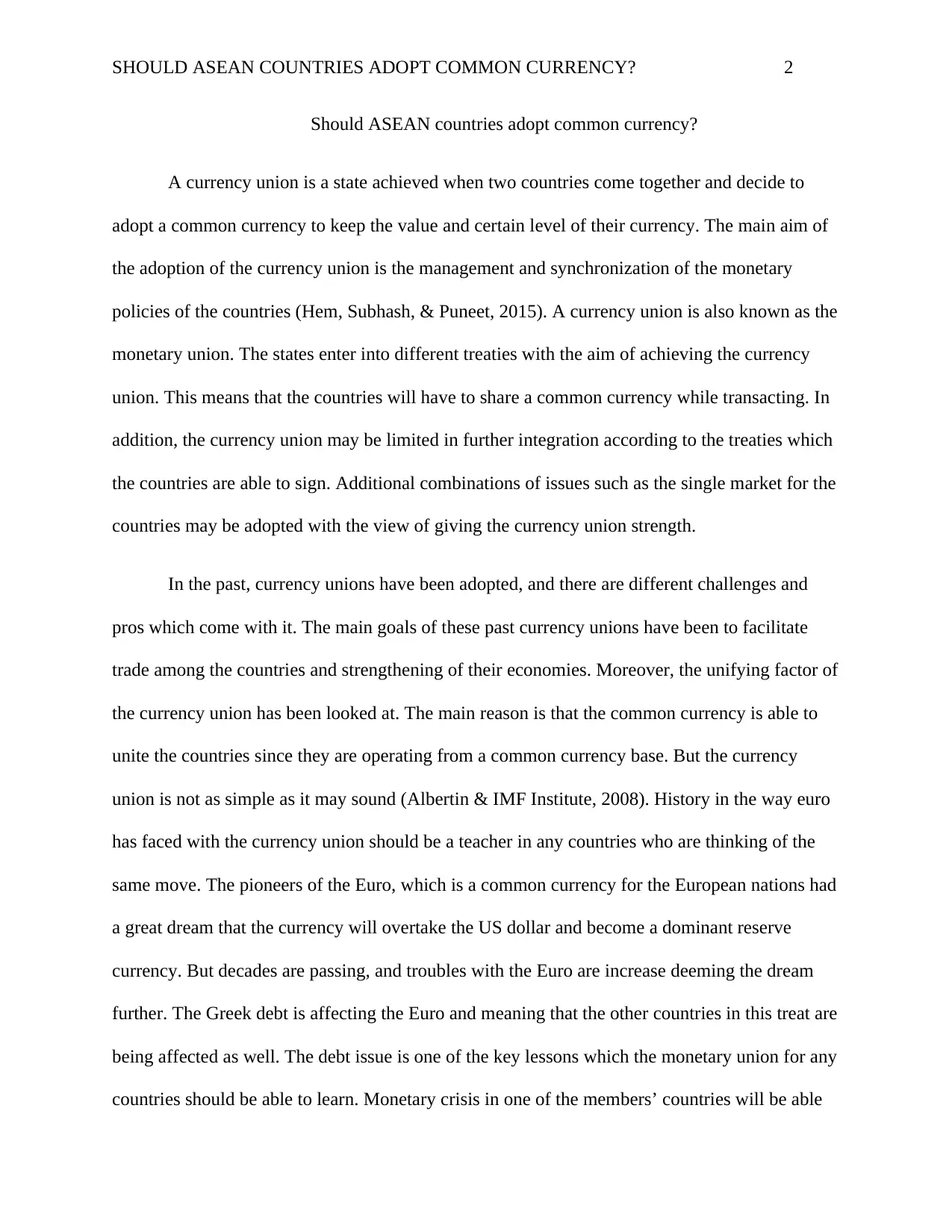
SHOULD ASEAN COUNTRIES ADOPT COMMON CURRENCY? 2
Should ASEAN countries adopt common currency?
A currency union is a state achieved when two countries come together and decide to
adopt a common currency to keep the value and certain level of their currency. The main aim of
the adoption of the currency union is the management and synchronization of the monetary
policies of the countries (Hem, Subhash, & Puneet, 2015). A currency union is also known as the
monetary union. The states enter into different treaties with the aim of achieving the currency
union. This means that the countries will have to share a common currency while transacting. In
addition, the currency union may be limited in further integration according to the treaties which
the countries are able to sign. Additional combinations of issues such as the single market for the
countries may be adopted with the view of giving the currency union strength.
In the past, currency unions have been adopted, and there are different challenges and
pros which come with it. The main goals of these past currency unions have been to facilitate
trade among the countries and strengthening of their economies. Moreover, the unifying factor of
the currency union has been looked at. The main reason is that the common currency is able to
unite the countries since they are operating from a common currency base. But the currency
union is not as simple as it may sound (Albertin & IMF Institute, 2008). History in the way euro
has faced with the currency union should be a teacher in any countries who are thinking of the
same move. The pioneers of the Euro, which is a common currency for the European nations had
a great dream that the currency will overtake the US dollar and become a dominant reserve
currency. But decades are passing, and troubles with the Euro are increase deeming the dream
further. The Greek debt is affecting the Euro and meaning that the other countries in this treat are
being affected as well. The debt issue is one of the key lessons which the monetary union for any
countries should be able to learn. Monetary crisis in one of the members’ countries will be able
Should ASEAN countries adopt common currency?
A currency union is a state achieved when two countries come together and decide to
adopt a common currency to keep the value and certain level of their currency. The main aim of
the adoption of the currency union is the management and synchronization of the monetary
policies of the countries (Hem, Subhash, & Puneet, 2015). A currency union is also known as the
monetary union. The states enter into different treaties with the aim of achieving the currency
union. This means that the countries will have to share a common currency while transacting. In
addition, the currency union may be limited in further integration according to the treaties which
the countries are able to sign. Additional combinations of issues such as the single market for the
countries may be adopted with the view of giving the currency union strength.
In the past, currency unions have been adopted, and there are different challenges and
pros which come with it. The main goals of these past currency unions have been to facilitate
trade among the countries and strengthening of their economies. Moreover, the unifying factor of
the currency union has been looked at. The main reason is that the common currency is able to
unite the countries since they are operating from a common currency base. But the currency
union is not as simple as it may sound (Albertin & IMF Institute, 2008). History in the way euro
has faced with the currency union should be a teacher in any countries who are thinking of the
same move. The pioneers of the Euro, which is a common currency for the European nations had
a great dream that the currency will overtake the US dollar and become a dominant reserve
currency. But decades are passing, and troubles with the Euro are increase deeming the dream
further. The Greek debt is affecting the Euro and meaning that the other countries in this treat are
being affected as well. The debt issue is one of the key lessons which the monetary union for any
countries should be able to learn. Monetary crisis in one of the members’ countries will be able
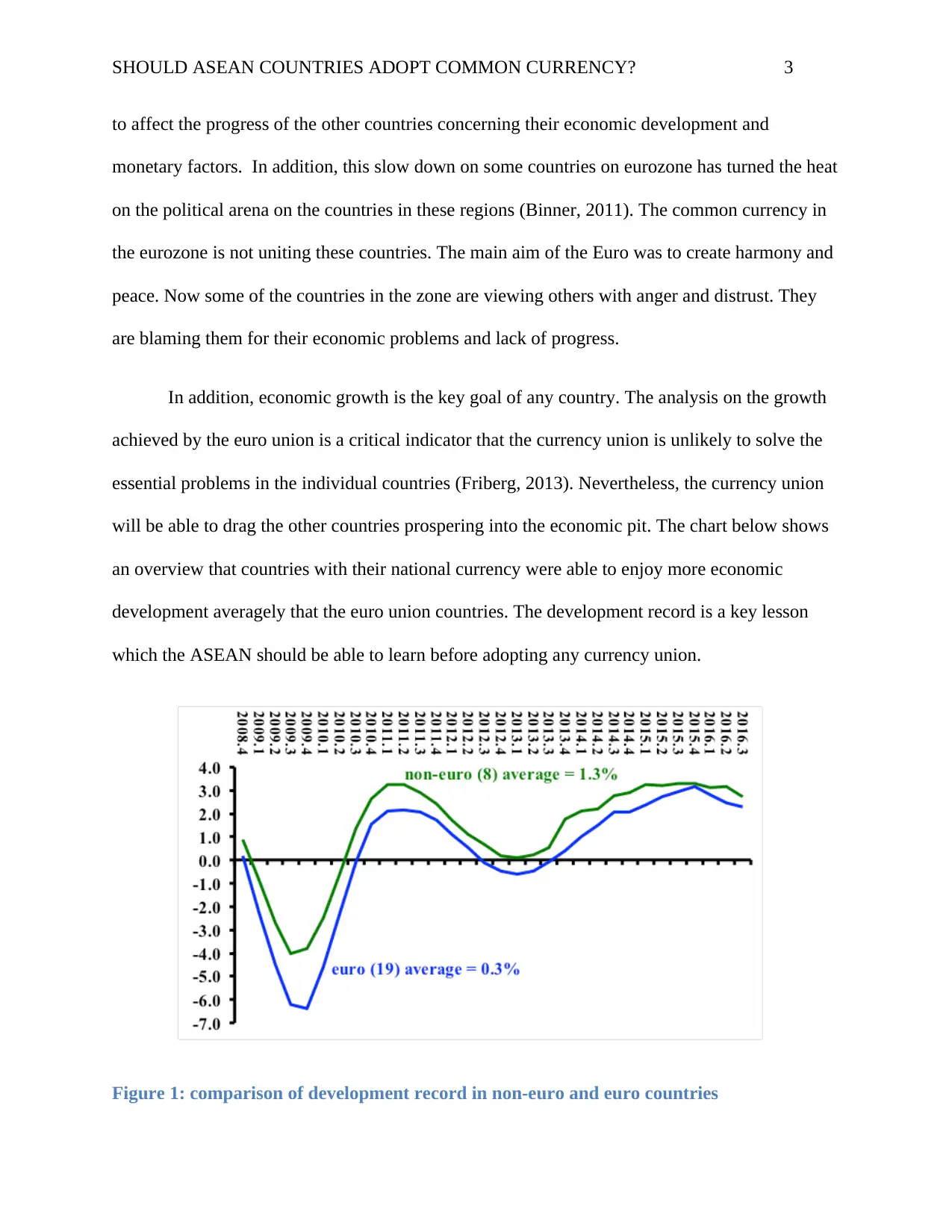
SHOULD ASEAN COUNTRIES ADOPT COMMON CURRENCY? 3
to affect the progress of the other countries concerning their economic development and
monetary factors. In addition, this slow down on some countries on eurozone has turned the heat
on the political arena on the countries in these regions (Binner, 2011). The common currency in
the eurozone is not uniting these countries. The main aim of the Euro was to create harmony and
peace. Now some of the countries in the zone are viewing others with anger and distrust. They
are blaming them for their economic problems and lack of progress.
In addition, economic growth is the key goal of any country. The analysis on the growth
achieved by the euro union is a critical indicator that the currency union is unlikely to solve the
essential problems in the individual countries (Friberg, 2013). Nevertheless, the currency union
will be able to drag the other countries prospering into the economic pit. The chart below shows
an overview that countries with their national currency were able to enjoy more economic
development averagely that the euro union countries. The development record is a key lesson
which the ASEAN should be able to learn before adopting any currency union.
Figure 1: comparison of development record in non-euro and euro countries
to affect the progress of the other countries concerning their economic development and
monetary factors. In addition, this slow down on some countries on eurozone has turned the heat
on the political arena on the countries in these regions (Binner, 2011). The common currency in
the eurozone is not uniting these countries. The main aim of the Euro was to create harmony and
peace. Now some of the countries in the zone are viewing others with anger and distrust. They
are blaming them for their economic problems and lack of progress.
In addition, economic growth is the key goal of any country. The analysis on the growth
achieved by the euro union is a critical indicator that the currency union is unlikely to solve the
essential problems in the individual countries (Friberg, 2013). Nevertheless, the currency union
will be able to drag the other countries prospering into the economic pit. The chart below shows
an overview that countries with their national currency were able to enjoy more economic
development averagely that the euro union countries. The development record is a key lesson
which the ASEAN should be able to learn before adopting any currency union.
Figure 1: comparison of development record in non-euro and euro countries
⊘ This is a preview!⊘
Do you want full access?
Subscribe today to unlock all pages.

Trusted by 1+ million students worldwide
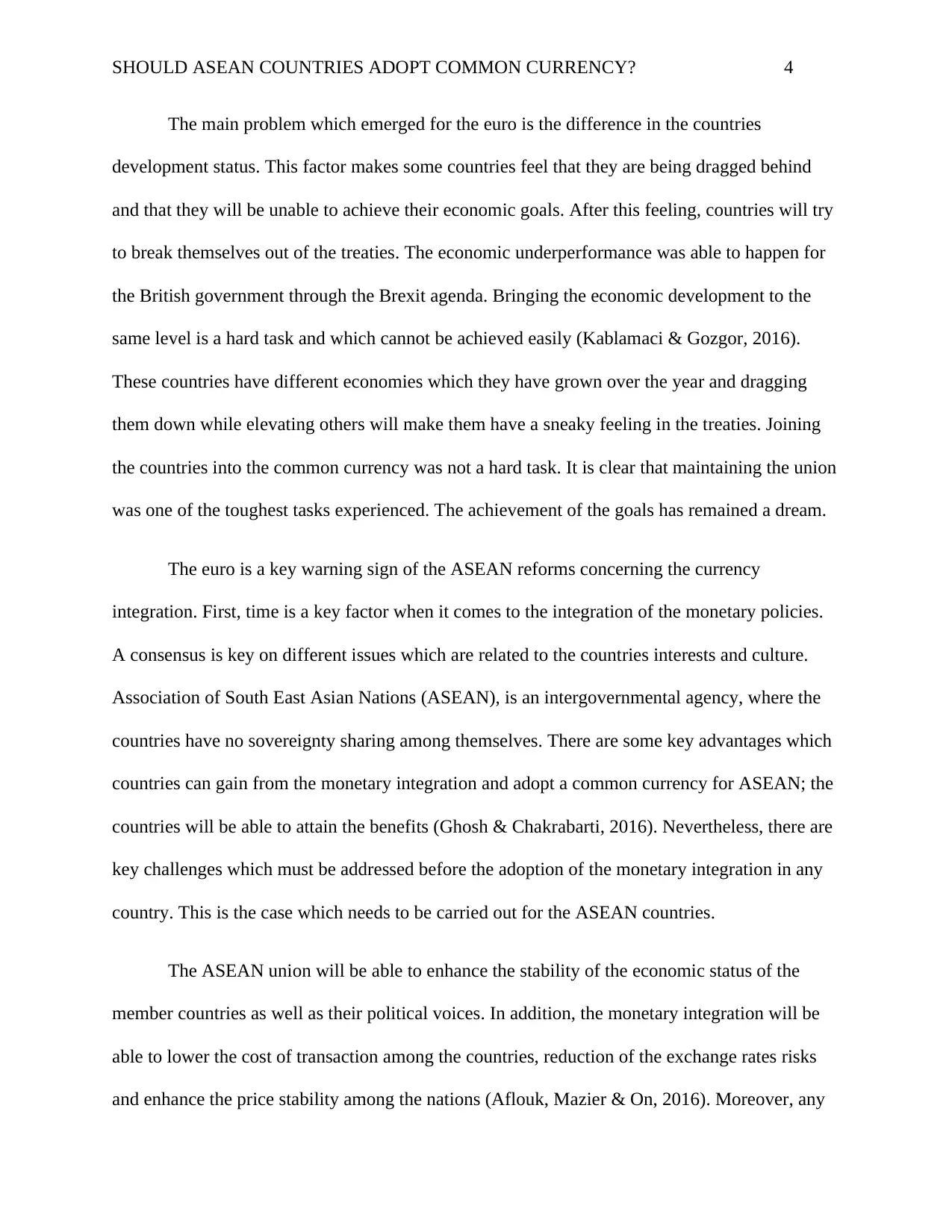
SHOULD ASEAN COUNTRIES ADOPT COMMON CURRENCY? 4
The main problem which emerged for the euro is the difference in the countries
development status. This factor makes some countries feel that they are being dragged behind
and that they will be unable to achieve their economic goals. After this feeling, countries will try
to break themselves out of the treaties. The economic underperformance was able to happen for
the British government through the Brexit agenda. Bringing the economic development to the
same level is a hard task and which cannot be achieved easily (Kablamaci & Gozgor, 2016).
These countries have different economies which they have grown over the year and dragging
them down while elevating others will make them have a sneaky feeling in the treaties. Joining
the countries into the common currency was not a hard task. It is clear that maintaining the union
was one of the toughest tasks experienced. The achievement of the goals has remained a dream.
The euro is a key warning sign of the ASEAN reforms concerning the currency
integration. First, time is a key factor when it comes to the integration of the monetary policies.
A consensus is key on different issues which are related to the countries interests and culture.
Association of South East Asian Nations (ASEAN), is an intergovernmental agency, where the
countries have no sovereignty sharing among themselves. There are some key advantages which
countries can gain from the monetary integration and adopt a common currency for ASEAN; the
countries will be able to attain the benefits (Ghosh & Chakrabarti, 2016). Nevertheless, there are
key challenges which must be addressed before the adoption of the monetary integration in any
country. This is the case which needs to be carried out for the ASEAN countries.
The ASEAN union will be able to enhance the stability of the economic status of the
member countries as well as their political voices. In addition, the monetary integration will be
able to lower the cost of transaction among the countries, reduction of the exchange rates risks
and enhance the price stability among the nations (Aflouk, Mazier & On, 2016). Moreover, any
The main problem which emerged for the euro is the difference in the countries
development status. This factor makes some countries feel that they are being dragged behind
and that they will be unable to achieve their economic goals. After this feeling, countries will try
to break themselves out of the treaties. The economic underperformance was able to happen for
the British government through the Brexit agenda. Bringing the economic development to the
same level is a hard task and which cannot be achieved easily (Kablamaci & Gozgor, 2016).
These countries have different economies which they have grown over the year and dragging
them down while elevating others will make them have a sneaky feeling in the treaties. Joining
the countries into the common currency was not a hard task. It is clear that maintaining the union
was one of the toughest tasks experienced. The achievement of the goals has remained a dream.
The euro is a key warning sign of the ASEAN reforms concerning the currency
integration. First, time is a key factor when it comes to the integration of the monetary policies.
A consensus is key on different issues which are related to the countries interests and culture.
Association of South East Asian Nations (ASEAN), is an intergovernmental agency, where the
countries have no sovereignty sharing among themselves. There are some key advantages which
countries can gain from the monetary integration and adopt a common currency for ASEAN; the
countries will be able to attain the benefits (Ghosh & Chakrabarti, 2016). Nevertheless, there are
key challenges which must be addressed before the adoption of the monetary integration in any
country. This is the case which needs to be carried out for the ASEAN countries.
The ASEAN union will be able to enhance the stability of the economic status of the
member countries as well as their political voices. In addition, the monetary integration will be
able to lower the cost of transaction among the countries, reduction of the exchange rates risks
and enhance the price stability among the nations (Aflouk, Mazier & On, 2016). Moreover, any
Paraphrase This Document
Need a fresh take? Get an instant paraphrase of this document with our AI Paraphraser
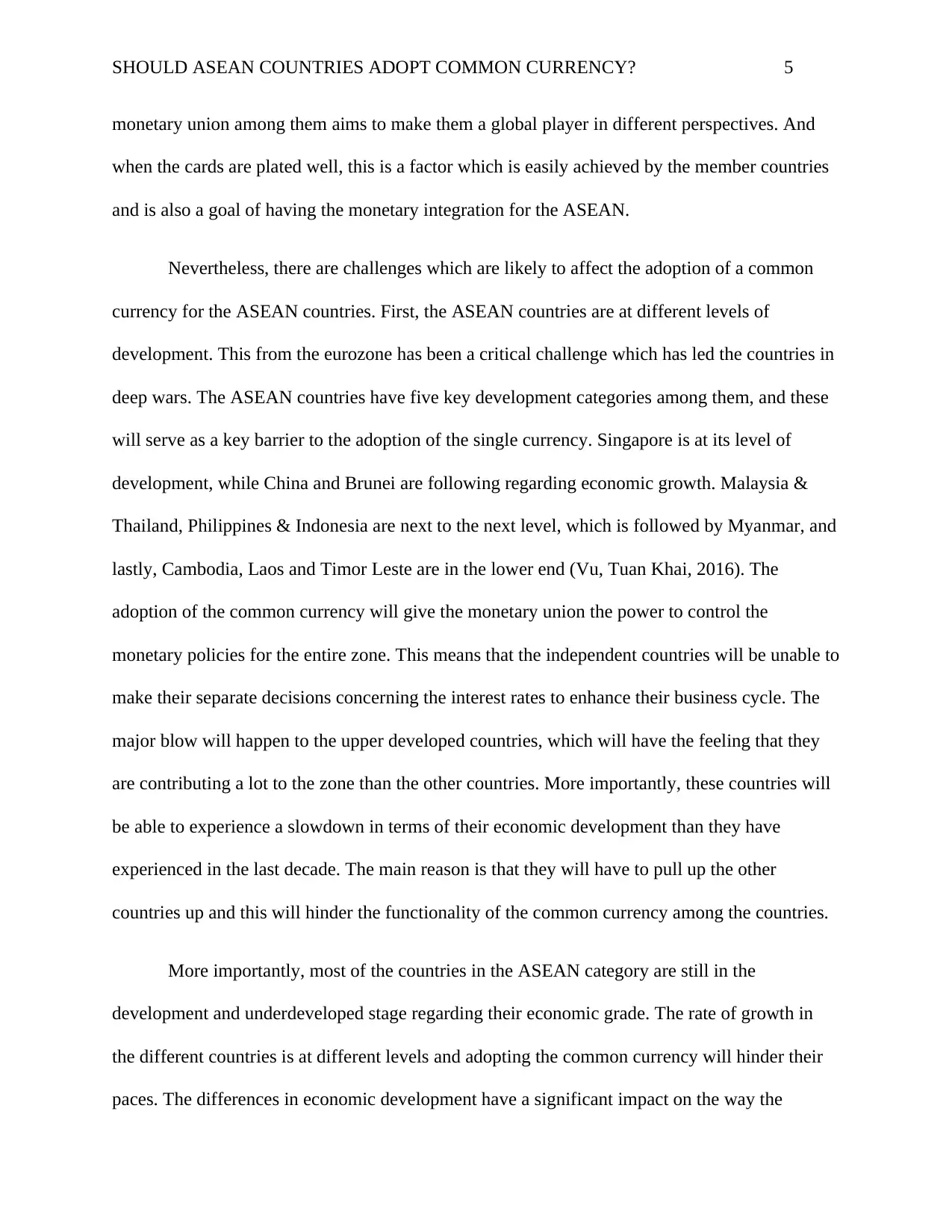
SHOULD ASEAN COUNTRIES ADOPT COMMON CURRENCY? 5
monetary union among them aims to make them a global player in different perspectives. And
when the cards are plated well, this is a factor which is easily achieved by the member countries
and is also a goal of having the monetary integration for the ASEAN.
Nevertheless, there are challenges which are likely to affect the adoption of a common
currency for the ASEAN countries. First, the ASEAN countries are at different levels of
development. This from the eurozone has been a critical challenge which has led the countries in
deep wars. The ASEAN countries have five key development categories among them, and these
will serve as a key barrier to the adoption of the single currency. Singapore is at its level of
development, while China and Brunei are following regarding economic growth. Malaysia &
Thailand, Philippines & Indonesia are next to the next level, which is followed by Myanmar, and
lastly, Cambodia, Laos and Timor Leste are in the lower end (Vu, Tuan Khai, 2016). The
adoption of the common currency will give the monetary union the power to control the
monetary policies for the entire zone. This means that the independent countries will be unable to
make their separate decisions concerning the interest rates to enhance their business cycle. The
major blow will happen to the upper developed countries, which will have the feeling that they
are contributing a lot to the zone than the other countries. More importantly, these countries will
be able to experience a slowdown in terms of their economic development than they have
experienced in the last decade. The main reason is that they will have to pull up the other
countries up and this will hinder the functionality of the common currency among the countries.
More importantly, most of the countries in the ASEAN category are still in the
development and underdeveloped stage regarding their economic grade. The rate of growth in
the different countries is at different levels and adopting the common currency will hinder their
paces. The differences in economic development have a significant impact on the way the
monetary union among them aims to make them a global player in different perspectives. And
when the cards are plated well, this is a factor which is easily achieved by the member countries
and is also a goal of having the monetary integration for the ASEAN.
Nevertheless, there are challenges which are likely to affect the adoption of a common
currency for the ASEAN countries. First, the ASEAN countries are at different levels of
development. This from the eurozone has been a critical challenge which has led the countries in
deep wars. The ASEAN countries have five key development categories among them, and these
will serve as a key barrier to the adoption of the single currency. Singapore is at its level of
development, while China and Brunei are following regarding economic growth. Malaysia &
Thailand, Philippines & Indonesia are next to the next level, which is followed by Myanmar, and
lastly, Cambodia, Laos and Timor Leste are in the lower end (Vu, Tuan Khai, 2016). The
adoption of the common currency will give the monetary union the power to control the
monetary policies for the entire zone. This means that the independent countries will be unable to
make their separate decisions concerning the interest rates to enhance their business cycle. The
major blow will happen to the upper developed countries, which will have the feeling that they
are contributing a lot to the zone than the other countries. More importantly, these countries will
be able to experience a slowdown in terms of their economic development than they have
experienced in the last decade. The main reason is that they will have to pull up the other
countries up and this will hinder the functionality of the common currency among the countries.
More importantly, most of the countries in the ASEAN category are still in the
development and underdeveloped stage regarding their economic grade. The rate of growth in
the different countries is at different levels and adopting the common currency will hinder their
paces. The differences in economic development have a significant impact on the way the
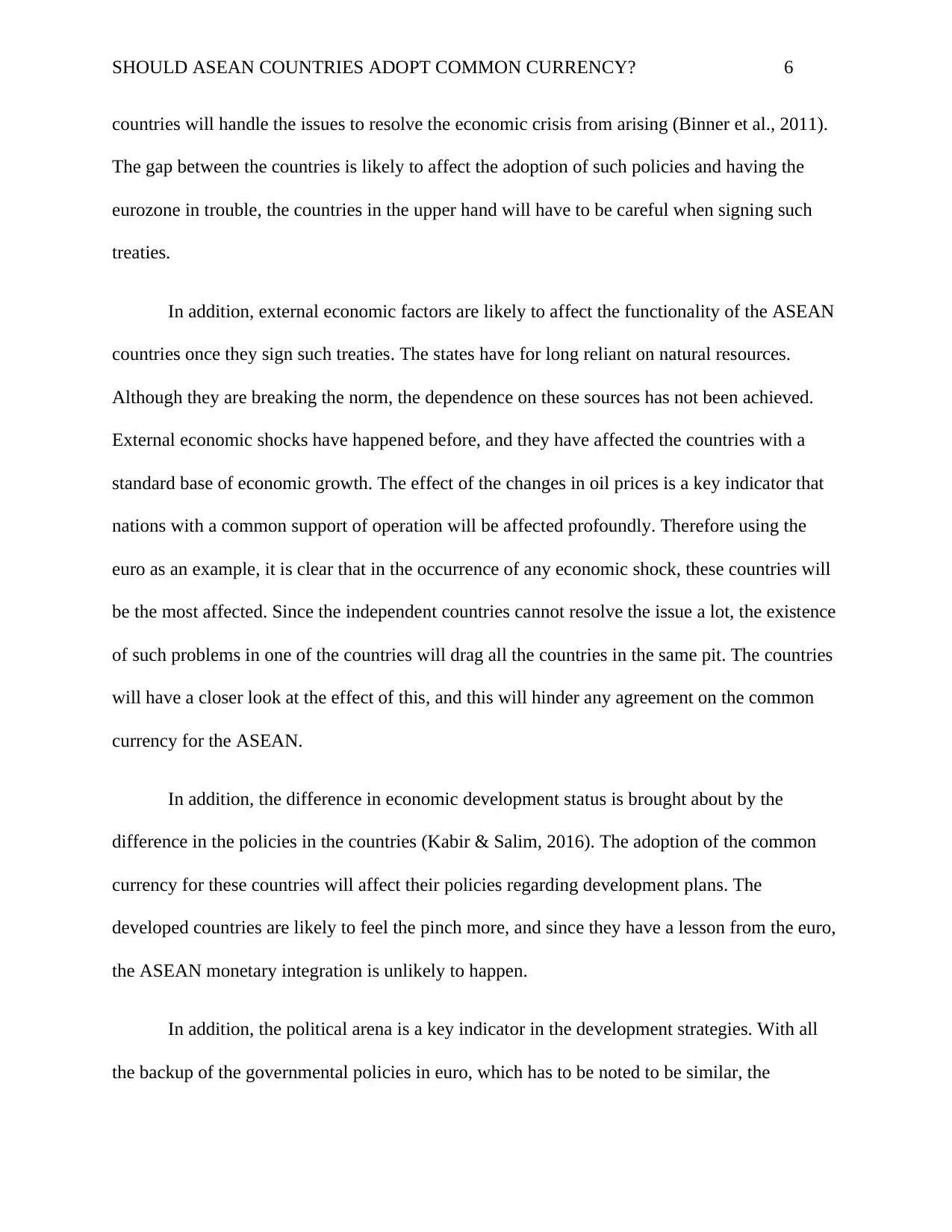
SHOULD ASEAN COUNTRIES ADOPT COMMON CURRENCY? 6
countries will handle the issues to resolve the economic crisis from arising (Binner et al., 2011).
The gap between the countries is likely to affect the adoption of such policies and having the
eurozone in trouble, the countries in the upper hand will have to be careful when signing such
treaties.
In addition, external economic factors are likely to affect the functionality of the ASEAN
countries once they sign such treaties. The states have for long reliant on natural resources.
Although they are breaking the norm, the dependence on these sources has not been achieved.
External economic shocks have happened before, and they have affected the countries with a
standard base of economic growth. The effect of the changes in oil prices is a key indicator that
nations with a common support of operation will be affected profoundly. Therefore using the
euro as an example, it is clear that in the occurrence of any economic shock, these countries will
be the most affected. Since the independent countries cannot resolve the issue a lot, the existence
of such problems in one of the countries will drag all the countries in the same pit. The countries
will have a closer look at the effect of this, and this will hinder any agreement on the common
currency for the ASEAN.
In addition, the difference in economic development status is brought about by the
difference in the policies in the countries (Kabir & Salim, 2016). The adoption of the common
currency for these countries will affect their policies regarding development plans. The
developed countries are likely to feel the pinch more, and since they have a lesson from the euro,
the ASEAN monetary integration is unlikely to happen.
In addition, the political arena is a key indicator in the development strategies. With all
the backup of the governmental policies in euro, which has to be noted to be similar, the
countries will handle the issues to resolve the economic crisis from arising (Binner et al., 2011).
The gap between the countries is likely to affect the adoption of such policies and having the
eurozone in trouble, the countries in the upper hand will have to be careful when signing such
treaties.
In addition, external economic factors are likely to affect the functionality of the ASEAN
countries once they sign such treaties. The states have for long reliant on natural resources.
Although they are breaking the norm, the dependence on these sources has not been achieved.
External economic shocks have happened before, and they have affected the countries with a
standard base of economic growth. The effect of the changes in oil prices is a key indicator that
nations with a common support of operation will be affected profoundly. Therefore using the
euro as an example, it is clear that in the occurrence of any economic shock, these countries will
be the most affected. Since the independent countries cannot resolve the issue a lot, the existence
of such problems in one of the countries will drag all the countries in the same pit. The countries
will have a closer look at the effect of this, and this will hinder any agreement on the common
currency for the ASEAN.
In addition, the difference in economic development status is brought about by the
difference in the policies in the countries (Kabir & Salim, 2016). The adoption of the common
currency for these countries will affect their policies regarding development plans. The
developed countries are likely to feel the pinch more, and since they have a lesson from the euro,
the ASEAN monetary integration is unlikely to happen.
In addition, the political arena is a key indicator in the development strategies. With all
the backup of the governmental policies in euro, which has to be noted to be similar, the
⊘ This is a preview!⊘
Do you want full access?
Subscribe today to unlock all pages.

Trusted by 1+ million students worldwide
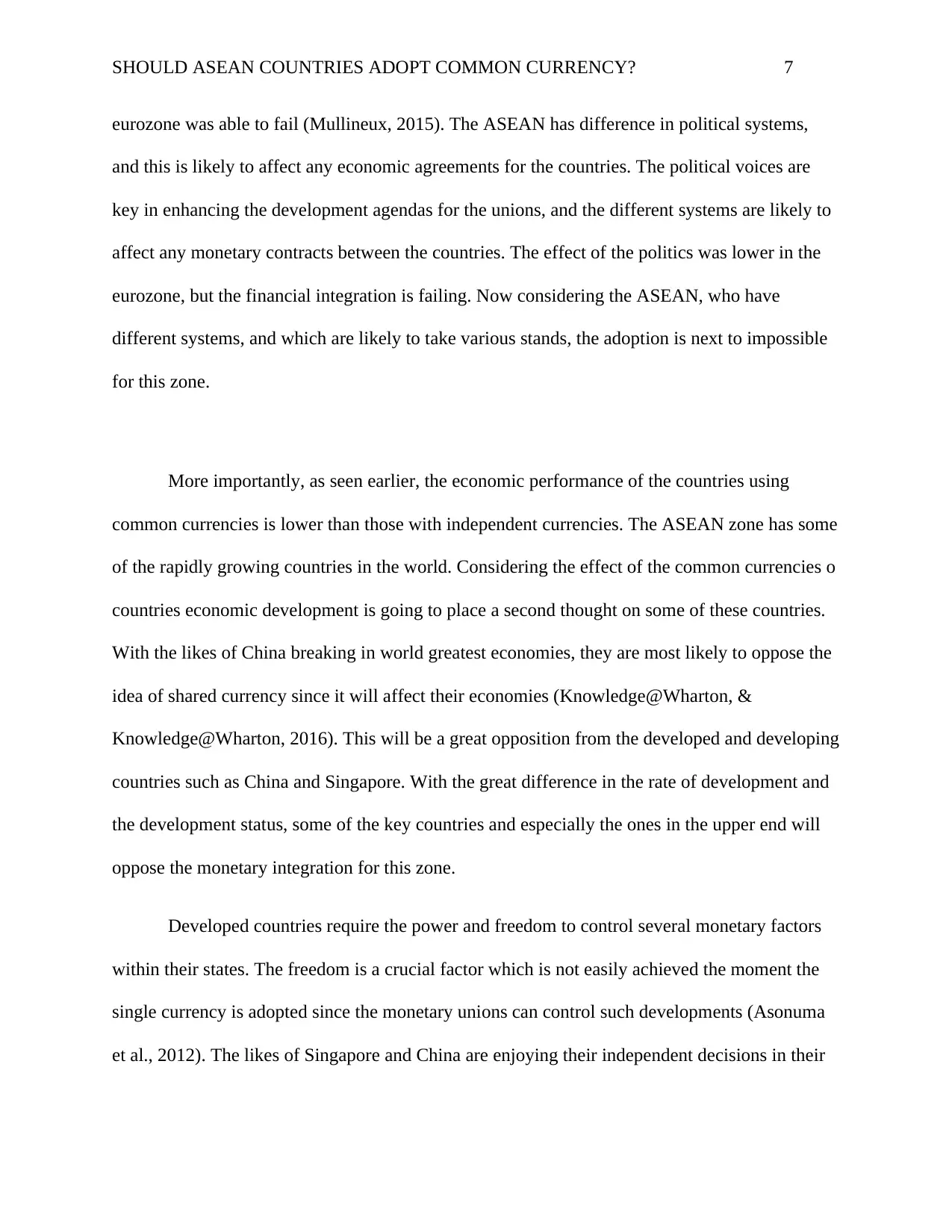
SHOULD ASEAN COUNTRIES ADOPT COMMON CURRENCY? 7
eurozone was able to fail (Mullineux, 2015). The ASEAN has difference in political systems,
and this is likely to affect any economic agreements for the countries. The political voices are
key in enhancing the development agendas for the unions, and the different systems are likely to
affect any monetary contracts between the countries. The effect of the politics was lower in the
eurozone, but the financial integration is failing. Now considering the ASEAN, who have
different systems, and which are likely to take various stands, the adoption is next to impossible
for this zone.
More importantly, as seen earlier, the economic performance of the countries using
common currencies is lower than those with independent currencies. The ASEAN zone has some
of the rapidly growing countries in the world. Considering the effect of the common currencies o
countries economic development is going to place a second thought on some of these countries.
With the likes of China breaking in world greatest economies, they are most likely to oppose the
idea of shared currency since it will affect their economies (Knowledge@Wharton, &
Knowledge@Wharton, 2016). This will be a great opposition from the developed and developing
countries such as China and Singapore. With the great difference in the rate of development and
the development status, some of the key countries and especially the ones in the upper end will
oppose the monetary integration for this zone.
Developed countries require the power and freedom to control several monetary factors
within their states. The freedom is a crucial factor which is not easily achieved the moment the
single currency is adopted since the monetary unions can control such developments (Asonuma
et al., 2012). The likes of Singapore and China are enjoying their independent decisions in their
eurozone was able to fail (Mullineux, 2015). The ASEAN has difference in political systems,
and this is likely to affect any economic agreements for the countries. The political voices are
key in enhancing the development agendas for the unions, and the different systems are likely to
affect any monetary contracts between the countries. The effect of the politics was lower in the
eurozone, but the financial integration is failing. Now considering the ASEAN, who have
different systems, and which are likely to take various stands, the adoption is next to impossible
for this zone.
More importantly, as seen earlier, the economic performance of the countries using
common currencies is lower than those with independent currencies. The ASEAN zone has some
of the rapidly growing countries in the world. Considering the effect of the common currencies o
countries economic development is going to place a second thought on some of these countries.
With the likes of China breaking in world greatest economies, they are most likely to oppose the
idea of shared currency since it will affect their economies (Knowledge@Wharton, &
Knowledge@Wharton, 2016). This will be a great opposition from the developed and developing
countries such as China and Singapore. With the great difference in the rate of development and
the development status, some of the key countries and especially the ones in the upper end will
oppose the monetary integration for this zone.
Developed countries require the power and freedom to control several monetary factors
within their states. The freedom is a crucial factor which is not easily achieved the moment the
single currency is adopted since the monetary unions can control such developments (Asonuma
et al., 2012). The likes of Singapore and China are enjoying their independent decisions in their
Paraphrase This Document
Need a fresh take? Get an instant paraphrase of this document with our AI Paraphraser
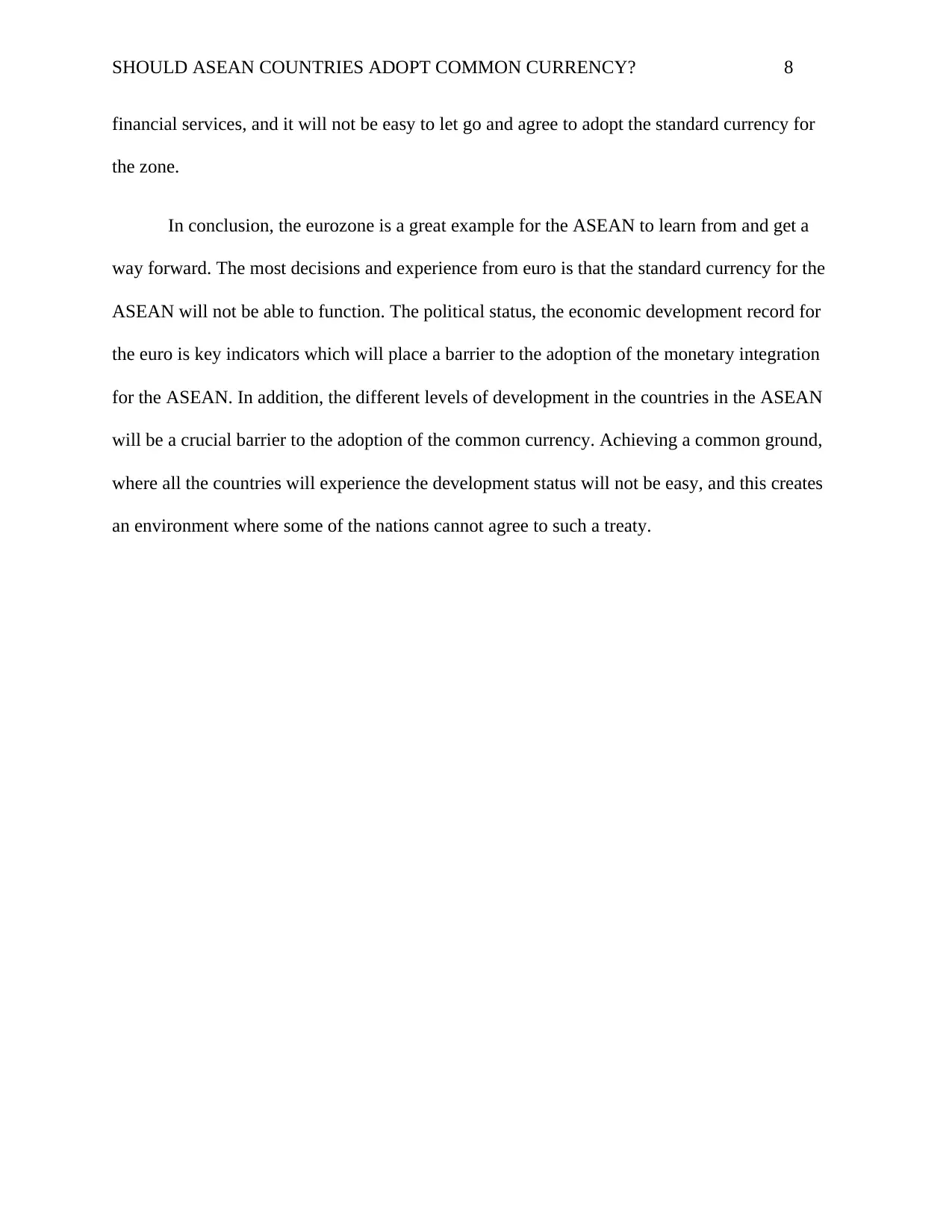
SHOULD ASEAN COUNTRIES ADOPT COMMON CURRENCY? 8
financial services, and it will not be easy to let go and agree to adopt the standard currency for
the zone.
In conclusion, the eurozone is a great example for the ASEAN to learn from and get a
way forward. The most decisions and experience from euro is that the standard currency for the
ASEAN will not be able to function. The political status, the economic development record for
the euro is key indicators which will place a barrier to the adoption of the monetary integration
for the ASEAN. In addition, the different levels of development in the countries in the ASEAN
will be a crucial barrier to the adoption of the common currency. Achieving a common ground,
where all the countries will experience the development status will not be easy, and this creates
an environment where some of the nations cannot agree to such a treaty.
financial services, and it will not be easy to let go and agree to adopt the standard currency for
the zone.
In conclusion, the eurozone is a great example for the ASEAN to learn from and get a
way forward. The most decisions and experience from euro is that the standard currency for the
ASEAN will not be able to function. The political status, the economic development record for
the euro is key indicators which will place a barrier to the adoption of the monetary integration
for the ASEAN. In addition, the different levels of development in the countries in the ASEAN
will be a crucial barrier to the adoption of the common currency. Achieving a common ground,
where all the countries will experience the development status will not be easy, and this creates
an environment where some of the nations cannot agree to such a treaty.
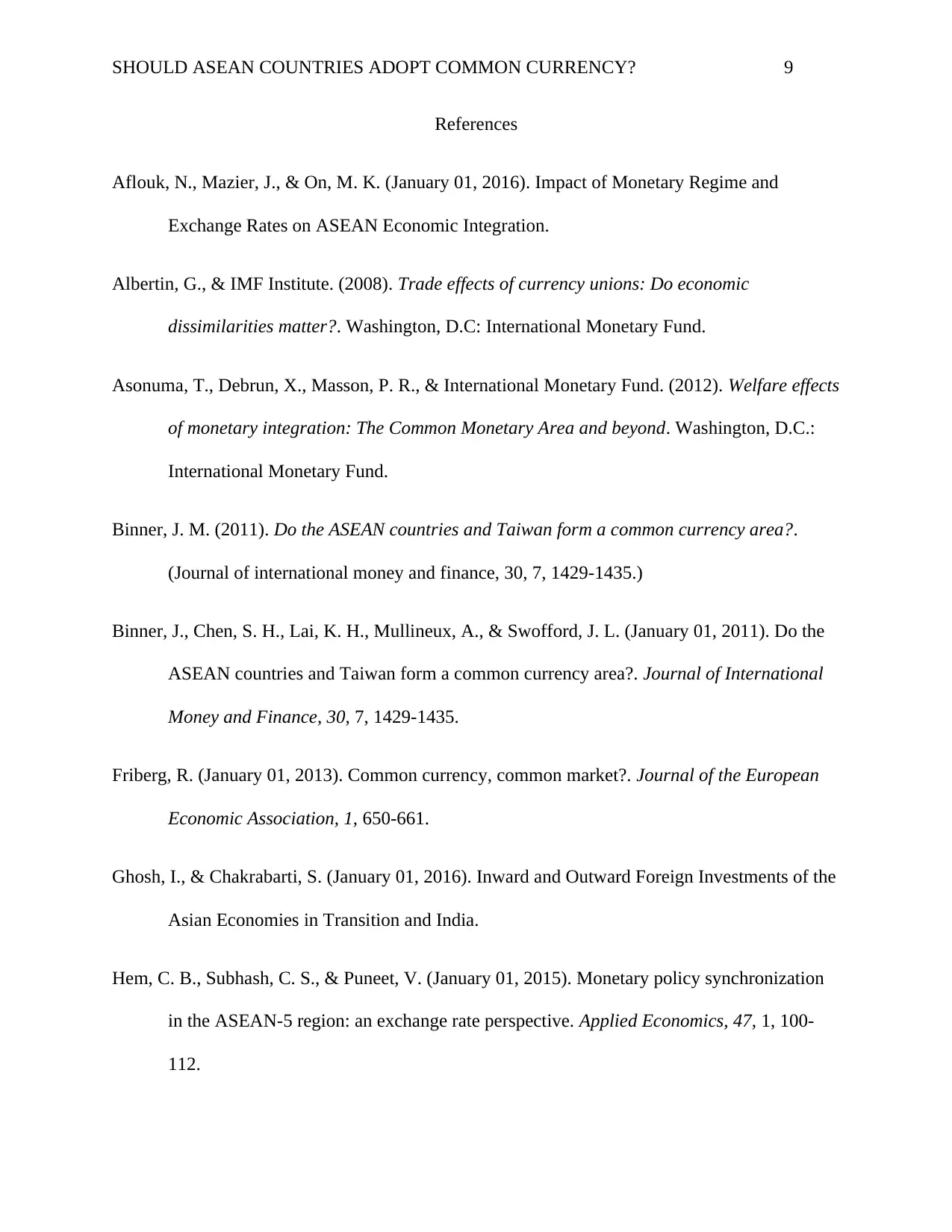
SHOULD ASEAN COUNTRIES ADOPT COMMON CURRENCY? 9
References
Aflouk, N., Mazier, J., & On, M. K. (January 01, 2016). Impact of Monetary Regime and
Exchange Rates on ASEAN Economic Integration.
Albertin, G., & IMF Institute. (2008). Trade effects of currency unions: Do economic
dissimilarities matter?. Washington, D.C: International Monetary Fund.
Asonuma, T., Debrun, X., Masson, P. R., & International Monetary Fund. (2012). Welfare effects
of monetary integration: The Common Monetary Area and beyond. Washington, D.C.:
International Monetary Fund.
Binner, J. M. (2011). Do the ASEAN countries and Taiwan form a common currency area?.
(Journal of international money and finance, 30, 7, 1429-1435.)
Binner, J., Chen, S. H., Lai, K. H., Mullineux, A., & Swofford, J. L. (January 01, 2011). Do the
ASEAN countries and Taiwan form a common currency area?. Journal of International
Money and Finance, 30, 7, 1429-1435.
Friberg, R. (January 01, 2013). Common currency, common market?. Journal of the European
Economic Association, 1, 650-661.
Ghosh, I., & Chakrabarti, S. (January 01, 2016). Inward and Outward Foreign Investments of the
Asian Economies in Transition and India.
Hem, C. B., Subhash, C. S., & Puneet, V. (January 01, 2015). Monetary policy synchronization
in the ASEAN-5 region: an exchange rate perspective. Applied Economics, 47, 1, 100-
112.
References
Aflouk, N., Mazier, J., & On, M. K. (January 01, 2016). Impact of Monetary Regime and
Exchange Rates on ASEAN Economic Integration.
Albertin, G., & IMF Institute. (2008). Trade effects of currency unions: Do economic
dissimilarities matter?. Washington, D.C: International Monetary Fund.
Asonuma, T., Debrun, X., Masson, P. R., & International Monetary Fund. (2012). Welfare effects
of monetary integration: The Common Monetary Area and beyond. Washington, D.C.:
International Monetary Fund.
Binner, J. M. (2011). Do the ASEAN countries and Taiwan form a common currency area?.
(Journal of international money and finance, 30, 7, 1429-1435.)
Binner, J., Chen, S. H., Lai, K. H., Mullineux, A., & Swofford, J. L. (January 01, 2011). Do the
ASEAN countries and Taiwan form a common currency area?. Journal of International
Money and Finance, 30, 7, 1429-1435.
Friberg, R. (January 01, 2013). Common currency, common market?. Journal of the European
Economic Association, 1, 650-661.
Ghosh, I., & Chakrabarti, S. (January 01, 2016). Inward and Outward Foreign Investments of the
Asian Economies in Transition and India.
Hem, C. B., Subhash, C. S., & Puneet, V. (January 01, 2015). Monetary policy synchronization
in the ASEAN-5 region: an exchange rate perspective. Applied Economics, 47, 1, 100-
112.
⊘ This is a preview!⊘
Do you want full access?
Subscribe today to unlock all pages.

Trusted by 1+ million students worldwide
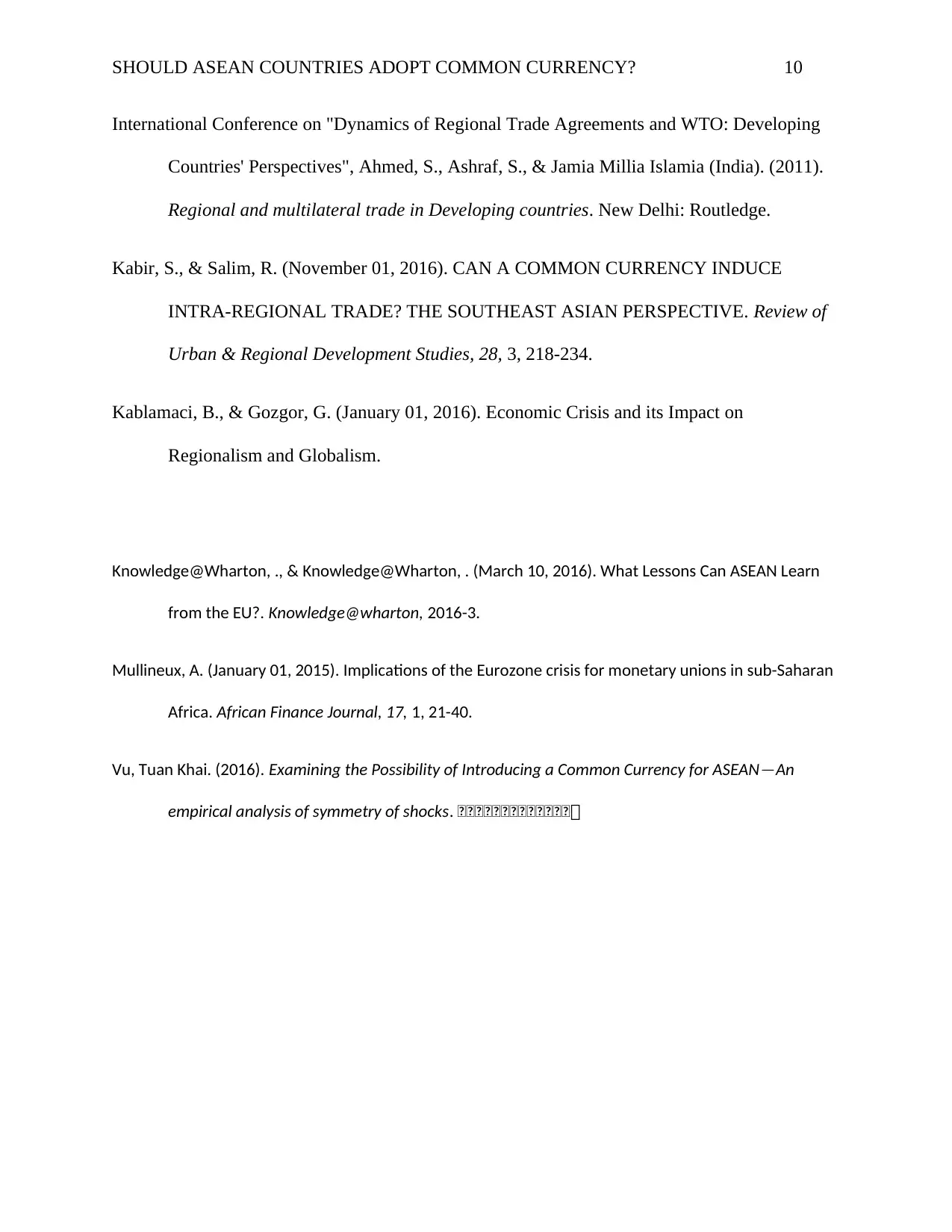
SHOULD ASEAN COUNTRIES ADOPT COMMON CURRENCY? 10
International Conference on "Dynamics of Regional Trade Agreements and WTO: Developing
Countries' Perspectives", Ahmed, S., Ashraf, S., & Jamia Millia Islamia (India). (2011).
Regional and multilateral trade in Developing countries. New Delhi: Routledge.
Kabir, S., & Salim, R. (November 01, 2016). CAN A COMMON CURRENCY INDUCE
INTRA-REGIONAL TRADE? THE SOUTHEAST ASIAN PERSPECTIVE. Review of
Urban & Regional Development Studies, 28, 3, 218-234.
Kablamaci, B., & Gozgor, G. (January 01, 2016). Economic Crisis and its Impact on
Regionalism and Globalism.
Knowledge@Wharton, ., & Knowledge@Wharton, . (March 10, 2016). What Lessons Can ASEAN Learn
from the EU?. Knowledge@wharton, 2016-3.
Mullineux, A. (January 01, 2015). Implications of the Eurozone crisis for monetary unions in sub-Saharan
Africa. African Finance Journal, 17, 1, 21-40.
Vu, Tuan Khai. (2016). Examining the Possibility of Introducing a Common Currency for ASEAN ─ An
empirical analysis of symmetry of shocks. 横横横横横横横横横横横横横会
International Conference on "Dynamics of Regional Trade Agreements and WTO: Developing
Countries' Perspectives", Ahmed, S., Ashraf, S., & Jamia Millia Islamia (India). (2011).
Regional and multilateral trade in Developing countries. New Delhi: Routledge.
Kabir, S., & Salim, R. (November 01, 2016). CAN A COMMON CURRENCY INDUCE
INTRA-REGIONAL TRADE? THE SOUTHEAST ASIAN PERSPECTIVE. Review of
Urban & Regional Development Studies, 28, 3, 218-234.
Kablamaci, B., & Gozgor, G. (January 01, 2016). Economic Crisis and its Impact on
Regionalism and Globalism.
Knowledge@Wharton, ., & Knowledge@Wharton, . (March 10, 2016). What Lessons Can ASEAN Learn
from the EU?. Knowledge@wharton, 2016-3.
Mullineux, A. (January 01, 2015). Implications of the Eurozone crisis for monetary unions in sub-Saharan
Africa. African Finance Journal, 17, 1, 21-40.
Vu, Tuan Khai. (2016). Examining the Possibility of Introducing a Common Currency for ASEAN ─ An
empirical analysis of symmetry of shocks. 横横横横横横横横横横横横横会
1 out of 10
Related Documents
Your All-in-One AI-Powered Toolkit for Academic Success.
+13062052269
info@desklib.com
Available 24*7 on WhatsApp / Email
![[object Object]](/_next/static/media/star-bottom.7253800d.svg)
Unlock your academic potential
Copyright © 2020–2025 A2Z Services. All Rights Reserved. Developed and managed by ZUCOL.





